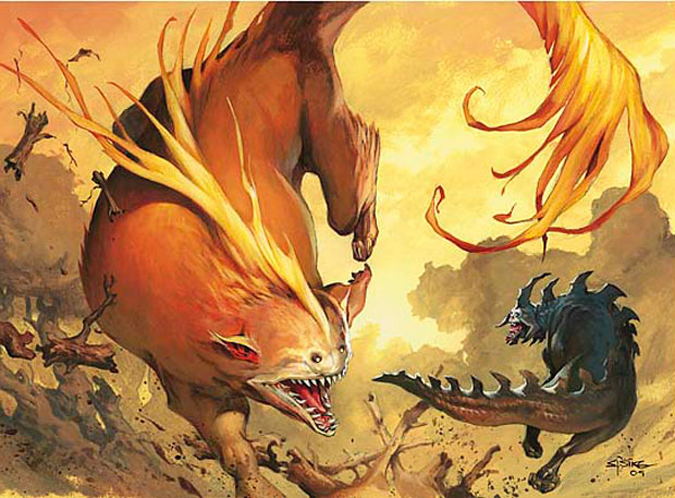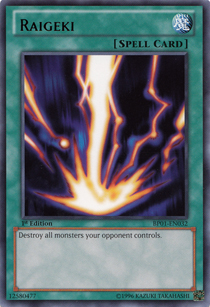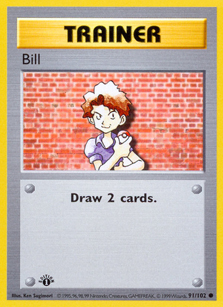Looking at Magic through the lens of game design is a bit different than doing the same for almost any other game. Magic is well established, but it’s also constantly changing, so most efforts are focused on new sets and the ways in which they stray from the norm. The actual norm is much harder to look at, but last week, on this very website, Devon Rule did just that. In his article, Devon worked to streamline the game we all know and love while keeping its core mechanics intact, but recently, I’ve been thinking about things on a different front.
You see, my friend Alex Kessler and I have just begun to design a new trading card game. I can’t tell you much about it just yet, but I can tell you that the very first thing we did was try to pin down what makes Magic the fantastic game it is and figure out which of those elements would help our game.
Creating a Genre
Nowadays, trading card games are commonplace. Pretty much every popular anime franchise has its own, and the comic book and video game industries are following suit. None of that existed when Richard Garfield was creating Magic. Without a doubt, the idea of a game in which the players chose the pieces is a powerful one. Nobody feels attached to the cars they move around the board in Monopoly, but for the vast majority of Magic players, their decks are extensions of their personalities, and that means that the players are invested in continuing to play because the outcome of each game says something about them.
This same involvement leads players to want to improve their decks, and as such, Magic and other games of its ilk encourage repeated purchasing, something Richard Garfield hadn’t anticipated at the game’s inception. In turn, the insurance that established players will continue to fund the venture is what allows Magic to evolve constantly, which then makes the game more appealing to continue investing in, forming a self-sustaining, upward spiral.

Helix Pinnacle by Dan Scott
Zooming In
The trading card game genre is fantastic, but obviously, Magic isn’t the only possible endpoint for it. One could look at differences between this game and its competitors, but some of the decisions seem so integral to the framework that they’re never questioned at all.
Why is Magic a competition? One could imagine an entirely different game in which the players tried to run a hospital, and each player would bring his or her own deck of surgeons with different areas of expertise and stocks of various medicines, but ultimately, the competitive element is more engaging. In a competitive game, players get to build rivalries against their friends, the difficulty of the game varies with the players’ skill levels, and perhaps most importantly, not everyone will be satisfied to stop playing once the game is done—somebody will be itching for a rematch.

Prey's Vengeance by Jesper Ejsing
Similarly, nobody questions the fact that games of Magic involve shuffling your deck beforehand but Zatch Bell! The Card Battle allows players to organize their spell books, essentially choosing what spells they’ll have access to on what turns. That’s not to say that Magic’s system is inferior; in fact, it’s more fun for all but the very spikiest of players because you don’t feel hopeless when you’ve already flipped past your answer to a given threat, and you don’t have to keep the entire order of your deck in mind at all times.
Inventing the Wheel
Most of these obvious things seem that way because the norm is vastly superior to the alternatives, but there are also plenty of game-design decisions for which Magic is in the minority, and it’s here where we’re most likely to find interesting pluses and minuses to each approach.
Besides creating the trading card game genre, I’d argue that Magic’s most important innovation was the creation of the color wheel. Once players are given the chance to build their own decks, they’re likely to pick the best tools for the job and leave everything else by the wayside, so the incompatible requirements of cards of different colors is essential to maintaining deck diversity. That said, many games take a less whole-hog approach to color restrictions than Magic does. Yu-Gi-Oh more or less does away with them entirely, and the Pokémon and Naruto games only require colors for attacking; as a result, each of these games has a much higher density of cards that it’s inexcusable not to play in every deck than even Magic’s early days.
 |
 |
Of course, Magic’s mana system goes beyond just having different colors. Lands are purely resource cards, and Pokémon’s energy cards follow suit, but Kaijudo and Naruto both allow players to use spells as resources. That’s a tempting path to go down. You get to avoid the mana flood and mana screw that players complain about endlessly—every deck always has a great draw! And that’s the problem. Variance is key to an enduring game experience, and in Magic, you never know how quickly your mana is going to develop.
Many tournament decks have 70% likelihoods of making it to 4 mana by turn four, but in Kaijudo, you’ll never miss your fourth land drop. Moreover, it feels bad to pitch your spells in order to cast your other spells, but you never need to feel bad about dropping a card that can never be anything other than a resource. Then again, Alex and I found a way to both replicate the variance in resource accumulation and dodge making decisions about what to make into resources without using anything like lands, but that’s a topic for another column.
Picking a Fight
Like Magic, most trading card games on the market involve smashing creatures into each other, but very few have adopted the same combat system. More often than not, combat involves creatures attacking one another sequentially. Sometimes players are hurt when they don’t have creatures to defend them, and sometimes even victory depends on defeating your opponents’ creatures. I’d wager that this system is widespread because it’s easier to process at a low level. If you’re a new Magic player, attacking is one of the scariest things you can do: First, you have to figure out all of the ways your opponent can block, then you have to figure out what you need to hold back to block your opponent’s surviving guys with. With sequential creature attacking, the high-level play is more complex because you have more distinct options than you can reasonably process, but at the start, things seem easy. If you can kill the opponent’s guy, you attack it, and then that creature won’t be able to attack you back.

Graphic by BigML
That’s a pretty big upside, and given that having a high barrier of entry is probably Magic’s greatest weakness, it might be the right choice, but the game’s current system is certainly not without its own benefits. It’s not nice to feel as though your creatures are sitting idly by while you opponent picks them apart, but more importantly, choosing blockers gives the non-active player something to do on the opponent’s turn. The alternative system mostly leaves each person playing solitaire on his or her own turn.
Two Can Play at That Game
All of these choices have done a lot to shape Magic into what it is today, but the fact that the game started one way doesn’t mean it has to stay that way. Using Darkpact to play for ante is one thing, but even if you just showed 1993 Richard Garfield Planechase or Magic: The Gathering Commander, I imagine he would be rather confused. You see, Magic is a two-player game; or at least it was. Conceiving the game as an all-out war between sworn enemies meant that there was no use for political cards or cards that scaled with the number of opponents in the game; needless to say, that policy changed quickly, and a year after the game’s release, we had both Typhoon and The Fallen. Nonetheless, that initial decision is still evident in the fact that cards such as Divination and Mind Rot are costed similarly, and as such, it has made effects that strip your opponents’ resources much weaker than cards that build up your resources in multiplayer games.
Another World
We might all be playing a whole ‘nother game right now if any of these decisions had been made differently, and trying to imagine what that game might be like is a good exercise for those of you interested in game design. For everyone else, I hope that looking into how Magic is built has been interesting and maybe has even helped you find some new strategies by emulating the way that other games play. Regardless, I’d love to hear your opinions on the subject and on whether you want to see more of this subject in the future.
[poll id=165]

























